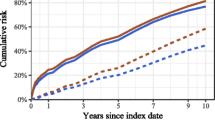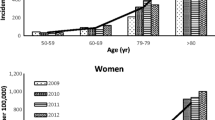Abstract
There is a paucity of data concerning the specific associations between hip fracture in the elderly and other age-related conditions, as well as its impact on long-term survival. This study was aimed to estimate the prevalence, risk factors, and outcome of self-reported hip fracture (srHF) in a cohort of Spanish elderly individuals. Neurological Disorders in Central Spain (NEDICES) is a census population-based survey of the prevalence and incidence of major age-associated conditions in three areas of central Spain. Data on health status and several chronic conditions were evaluated in the baseline questionnaire (1994–1995). Odds ratios for the association between srHF and other comorbidities and health-related variables were assessed by logistic regression. A Cox model estimated the impact of srHF on 13-year all-cause mortality. The final cohort comprised 5,278 community-living elderly subjects. A total of 166 participants (3.1%) had srHF. Prevalence was associated with higher age, female gender, degree of urbanisation of residence place, lower body mass index (BMI), higher number of chronic medications, higher Pfeffer FAQ score, being unmarried (P < 0.001 for all), and infantile living conditions (P = 0.007). Participants with srHF had a higher number of associated chronic conditions (P < 0.001). In the multivariate analysis, self-reported osteoporosis, lower BMI category, rural environment during childhood, and higher age were identified as independent risk factors for srHF. Adjusted hazard ratio for mortality in the srHF group was 1.40 (95% confidence interval 1.15–1.71; P = 0.001). srHF is a common condition among community-living elderly population in Spain, and has a significant impact upon long-term all-cause mortality.

Similar content being viewed by others
References
Wolinsky FD, Fitzgerald JF, Stump TE (1997) The effect of hip fracture on mortality, hospitalization, and functional status: a prospective study. Am J Public Health 87:398–403
Haentjens P, Magaziner J, Colón-Emeric CS, Vanderschueren D, Milisen K, Velkeniers B, Boonen S (2010) Meta-analysis: excess mortality after hip fracture among older women and men. Ann Intern Med 152:380–390
Hernández JL, Olmos JM, Alonso MA, González-Fernández CR, Martínez J, Pajarón M, Llorca J, González-Macías J (2006) Trend in hip fracture epidemiology over a 14-year period in a Spanish population. Osteoporos Int 17:464–470
Alvarez-Nebreda ML, Jiménez AB, Rodríguez P, Serra JA (2008) Epidemiology of hip fracture in the elderly in Spain. Bone 42:278–285
Herrera A, Martínez AA, Ferrandez L, Gil E, Moreno A (2006) Epidemiology of osteoporotic hip fractures in Spain. Int Orthop 30:11–14
Bush TL, Miller SR, Golden AL, Hale WE (1989) Self-report and medical record report agreement of selected medical conditions in the elderly. Am J Public Health 79:1554–1556
Heliövaara M, Aromaa A, Klaukka T, Knekt P, Joukamaa M, Impivaara O (1993) Reliability and validity of interview data on chronic diseases. The Mini-Finland Health Survey. J Clin Epidemiol 46:181–191
Simpson CF, Boyd CM, Carlson MC, Griswold ME, Guralnik JM, Fried LP (2004) Agreement between self-report of disease diagnoses and medical record validation in disabled older women: factors that modify agreement. J Am Geriatr Soc 52:123–127
Bayliss EA, Ellis JL, Steiner JF (2005) Subjective assessments of comorbidity correlate with quality of life health outcomes: initial validation of a comorbidity assessment instrument. Health Qual Life Outcomes 3:51. doi:10.1186/1477-7525-3-51
Sangha O, Stucki G, Liang MH, Fossel AH, Katz JN (2003) The Self-Administered Comorbidity Questionnaire: a new method to assess comorbidity for clinical and health services research. Arthritis Rheum 49:156–163
Chaudhry S, Jin L, Meltzer D (2005) Use of a self-report-generated Charlson Comorbidity Index for predicting mortality. Med Care 43:607–615
Hochberg MC, Williamson J, Skinner EA, Guralnik J, Kasper JD, Fried LP (1998) The prevalence and impact of self-reported hip fracture in elderly community-dwelling women: the Women’s Health and Aging Study. Osteoporos Int 8:385–389
Nevitt MC, Cummings SR, Browner WS, Seeley DG, Cauley JA, Vogt TM, Bñack DM (1992) The accuracy of self-report of fractures in elderly women: evidence from a prospective study. Am J Epidemiol 135:490–499
Paganini-Hill A, Chao A (1993) Accuracy of recall of hip fracture, heart attack, and cancer: a comparison of postal survey data and medical records. Am J Epidemiol 138:101–106
Diez A, Puig J, Martinez MT, Diez JL, Aubia J, Vivancos J (1989) Epidemiology of fractures of the proximal femur associated with osteoporosis in Barcelona, Spain. Calcif Tissue Int 44:382–386
Sosa M, Segarra MC, Hernández D, González A, Limiñana JM, Betancor P (1993) Epidemiology of proximal femoral fracture in Gran Canaria (Canary Islands). Age Ageing 22:285–288
Naves M, Díaz-López JB, Gómez C, Rodríguez-Rebollar A, Cannata-Andía JB (2005) Determinants of incidence of osteoporotic fractures in the female Spanish population older than 50. Osteoporos Int 16:2013–2017
Alegre-López J, Cordero-Guevara J, Alonso-Valdivielso JL, Fernández-Melón J (2005) Factors associated with mortality and functional disability after hip fracture: an inception cohort study. Osteoporos Int 16:729–736
Serra JA, Garrido G, Vidán M, Marañón E, Brañas F, Ortiz J (2002) Epidemiology of hip fractures in the elderly in Spain. An Med Interna 19:389–395
Benito-Leon J, Bermejo-Pareja F, Morales JM, Vega S, Molina JA (2003) Prevalence of essential tremor in three elderly populations of central Spain. Mov Disord 18:389–394
Benito-Leon J, Bermejo-Pareja F, Rodriguez J, Molina JA, Gabriel R, Morales JM, Neurological Disorders in Central Spain (NEDICES) Study Group (2003) Prevalence of PD and other types of parkinsonism in three elderly populations of central Spain. Mov Disord 18:267–274
Díaz-Guzmán J, Bermejo-Pareja F, Benito-León J, Vega S, Gabriel R, Medrano MJ, Neurological Disorders in Central Spain (NEDICES) Study Group (2008) Prevalence of stroke and transient ischemic attack in three elderly populations of central Spain. Neuroepidemiology 30:247–253
Bermejo-Pareja F, Benito-León J, Vega S, Olazarán J, de Toledo M, Díaz-Guzmán J, Sánchez-Sánchez F, Morales-González JM, Trincado R, Portera-Sánchez A, Román GC (2009) Consistency of clinical diagnosis of dementia in NEDICES: a population-based longitudinal study in Spain. J Geriatr Psychiatry Neurol 22:246–255
Bermejo Pareja F (ed) (2007) Cohorte de ancianos NEDICES. Datos generales y de salud. EDIMSA, Madrid
Morales JM, Bermejo FP, Benito-León J, Rivera-Navarro J, Trincado R, Gabriel SR, Vega S, NEDICES Study Group (2004) Methods and demographic findings of the baseline survey of the NEDICES cohort: a door-to-door survey of neurological disorders in three communities from Central Spain. Public Health 118:426–433
Folstein MF, Folstein SE, McHugh PR (1975) “Mini-mental state”. A practical method for grading the cognitive state of patients for the clinician. J Psychiatr Res 12:189–198
Pfeffer RI, Kurosaki TT, Harrah CH Jr, Chance JM, Filos S (1982) Measurement of functional activities in older adults in the community. J Gerontol 37:323–329
Guccione AA, Felson DT, Anderson JJ, Anthony JM, Zhang Y, Wilson PW, Kelly-Hayes M, Wolf PA, Kreger BE, Kannel WB (1994) The effects of specific medical conditions on the functional limitations of elders in the Framingham Study. Am J Public Health 84:351–358
Ahmed LA, Schirmer H, Berntsen GK, Fønnebø V, Joakimsen RM (2006) Self-reported diseases and the risk of non-vertebral fractures: the Tromsø study. Osteoporos Int 17:46–53
Fuchs Z, Blumstein T, Novikov I, Walter-Ginzburg A, Lyanders M, Gindin J, Habot B, Modan B (1998) Morbidity, comorbidity, and their association with disability among community-dwelling oldest-old in Israel. J Gerontol A Biol Sci Med Sci 53:M447–M455
Valderrama-Gama E, Damián J, Ruigómez A, Martín-Moreno JM (2002) Chronic disease, functional status, and self-ascribed causes of disabilities among noninstitutionalized older people in Spain. J Gerontol A Biol Sci Med Sci 57:M716–M721
Hagino T, Ochiai S, Sato E, Maekawa S, Wako M, Haro H (2009) The relationship between anemia at admission and outcome in patients older than 60 years with hip fracture. J Orthop Traumatol 10:119–122
Felson DT, Anderson JJ, Hannan MT, Milton RC, Wilson PW, Kiel DP (1989) Impaired vision and hip fracture. The Framingham Study. J Am Geriatr Soc 37:495–500
Grue EV, Kirkevold M, Ranhoff AH (2009) Prevalence of vision, hearing, and combined vision and hearing impairments in patients with hip fractures. J Clin Nurs 18:3037–3049
Collins TC, Ewing SK, Diem SJ, Taylor BC, Orwoll ES, Cummings SR, Strotmeyer ES, Ensrud KE, Osteoporotic Fractures in Men (MrOS) Study Group (2009) Peripheral arterial disease is associated with higher rates of hip bone loss and increased fracture risk in older men. Circulation 119:2305–2312
Lai SW, Liao KF, Liao CC, Muo CH, Liu CS, Sung FC (2010) Polypharmacy correlates with increased risk for hip fracture in the elderly: a population-based study. Medicine (Baltimore) 89:295–299
Hökby A, Reimers A, Laflamme L (2003) Hip fractures among older people: do marital status and type of residence matter? Public Health 117:196–201
Pérez-Castrillón JL, Martín-Escudero JC, delPino-Montes J, Blanco FS, Martín FJ, Paredes MG, Fernández FP, Arés TA (2005) Prevalence of osteoporosis using DXA bone mineral density measurements at the calcaneus: cut-off points of diagnosis and exclusion of osteoporosis. J Clin Densitom 8:404–408
Brennan SL, Pasco JA, Urquhart DM, Oldenburg B, Hanna FS, Wluka AE (2010) The association between urban or rural locality and hip fracture in community-based adults: a systematic review. J Epidemiol Community Health 64:656–665
Cooper C, Harvey N, Cole Z, Hanson M, Dennison E (2009) Developmental origins of osteoporosis: the role of maternal nutrition. Adv Exp Med Biol 646:31–39
Acknowledgments
A complete list of the investigators and advisors of the NEDICES Study Group is exposed in http://www.ciberned.es and http://www.neurologia12o.com. We also thank Joseph Healey for the review of the English manuscript. This work was partly supported by the Fundación Mutua Madrileña [2006–9]; the Spanish Health Research Agency [FIS 93/0773]; the Centro de Investigación Biomédica en Red sobre Enfermedades Neurodegenerativas (CIBERNED); and the National Institutes of Health [NIH R01 NS039422 to J.B.L and F.B.P.].
Conflict of interest
None.
Author information
Authors and Affiliations
Corresponding author
Rights and permissions
About this article
Cite this article
Fernández-Ruiz, M., Guerra-Vales, J.M., Trincado, R. et al. Hip fracture in three elderly populations of central Spain: data from the NEDICES study. Intern Emerg Med 9, 33–41 (2014). https://doi.org/10.1007/s11739-011-0728-y
Received:
Accepted:
Published:
Issue Date:
DOI: https://doi.org/10.1007/s11739-011-0728-y




